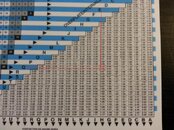mmadiver:
So, what do you do? Halve your NDL? Add a pressure group, or reduce your depth to move up one? Knock 25% off your NDL? A 5 min. safety stop instead of a 3? Do a deep stop? Stay on the boat if you can't run a mile in 10 minutes (inside joke from another thread)?
What's 'good enough' conservatism?
Richard.
That's the precise point I was trying to make in the other thread. On easy dives I exit the water at 85% of the M-Value, on deep, cold, (insert variable) dives I come out at 70% of the maximum M-Value. You'll notice earlier in thread we looked at some quotes from the manual. Everyone closely reviewed the disclaimers, but what's more interesting is the conservative GF settings available in Tec mode.
If you look at the data available, and you're worried about decompression stress, perhaps running 30/70 or 30/75 makes a lot of sense. In fact, Shearwater ships computers set at 30/70 out of the box, but that 70 will certainly make you unfriendly with your other dive buddies as it will negatively impact your NDLs versus a recreational dive computer significantly. The good news is you can learn about the model, look at the success statistics and then make choices. If you want to run bubble model, you can add VPM if you like via unlock code. Whatever makes you happy.






